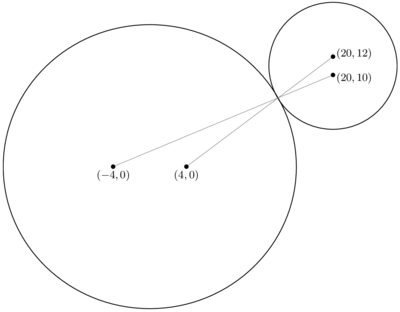Difference between revisions of "2022 AIME II Problems/Problem 12"
m (→Solution) |
m (→Solution) |
||
| Line 12: | Line 12: | ||
Because <math>\frac{(x-20)^2}{b^2-1}+\frac{(y-11)^2}{b^2} = 1</math>, <math>P</math> is on an ellipse whose center is <math>\left( 20 , 11 \right)</math> and foci are <math>\left( 20 , 10 \right)</math> and <math>\left( 20 , 12 \right)</math>. | Because <math>\frac{(x-20)^2}{b^2-1}+\frac{(y-11)^2}{b^2} = 1</math>, <math>P</math> is on an ellipse whose center is <math>\left( 20 , 11 \right)</math> and foci are <math>\left( 20 , 10 \right)</math> and <math>\left( 20 , 12 \right)</math>. | ||
| + | |||
| + | [[File:AIME-II-2022-12.png|400px|right]] | ||
Hence, the sum of distance from <math>P</math> to <math>\left( 20 , 10 \right)</math> and <math>\left( 20 , 12 \right)</math> is equal to twice the semi-major axis of this ellipse, <math>2b</math>. | Hence, the sum of distance from <math>P</math> to <math>\left( 20 , 10 \right)</math> and <math>\left( 20 , 12 \right)</math> is equal to twice the semi-major axis of this ellipse, <math>2b</math>. | ||
Therefore, <math>2a + 2b</math> is the sum of the distance from <math>P</math> to four foci of these two ellipses. | Therefore, <math>2a + 2b</math> is the sum of the distance from <math>P</math> to four foci of these two ellipses. | ||
| − | To | + | To minimize this, <math>P</math> must be the intersection point of the line that passes through <math>\left( - 4 , 0 \right)</math> and <math>\left( 20 , 10 \right)</math>, and the line that passes through <math>\left( 4 , 0 \right)</math> and <math>\left( 20 , 12 \right)</math>. |
The distance between <math>\left( - 4 , 0 \right)</math> and <math>\left( 20 , 10 \right)</math> is <math>\sqrt{\left( 20 + 4 \right)^2 + \left( 10 - 0 \right)^2} = 26</math>. | The distance between <math>\left( - 4 , 0 \right)</math> and <math>\left( 20 , 10 \right)</math> is <math>\sqrt{\left( 20 + 4 \right)^2 + \left( 10 - 0 \right)^2} = 26</math>. | ||
| Line 22: | Line 24: | ||
The distance between <math>\left( 4 , 0 \right)</math> and <math>\left( 20 , 12 \right)</math> is <math>\sqrt{\left( 20 - 4 \right)^2 + \left( 12 - 0 \right)^2} = 20</math>. | The distance between <math>\left( 4 , 0 \right)</math> and <math>\left( 20 , 12 \right)</math> is <math>\sqrt{\left( 20 - 4 \right)^2 + \left( 12 - 0 \right)^2} = 20</math>. | ||
| − | Hence, <math>2 a + 2 b = 26 + 20 = 46</math>. | + | Hence, <math>2 a + 2 b = 26 + 20 = 46</math>. Therefore, <math>a + b \ge 23</math>. |
| − | |||
| − | |||
The straight line connecting the points <math>\left(–4, 0 \right)</math> and <math>\left(20, 10 \right)</math> has the equation <math>5x+20=12y</math>. | The straight line connecting the points <math>\left(–4, 0 \right)</math> and <math>\left(20, 10 \right)</math> has the equation <math>5x+20=12y</math>. | ||
The straight line connecting the points <math>\left(4, 0 \right)</math> and <math>\left(20, 12 \right)</math> has the equation <math>3x-12=4y</math>. | The straight line connecting the points <math>\left(4, 0 \right)</math> and <math>\left(20, 12 \right)</math> has the equation <math>3x-12=4y</math>. | ||
Revision as of 14:57, 25 December 2022
Problem
Let ![]() and
and ![]() be real numbers with
be real numbers with ![]() and
and ![]() such that
such that![]() Find the least possible value of
Find the least possible value of ![]()
Solution
Denote ![]() .
.
Because ![]() ,
, ![]() is on an ellipse whose center is
is on an ellipse whose center is ![]() and foci are
and foci are ![]() and
and ![]() .
.
Hence, the sum of distance from ![]() to
to ![]() and
and ![]() is equal to twice the semi-major axis of this ellipse,
is equal to twice the semi-major axis of this ellipse, ![]() .
.
Because ![]() ,
, ![]() is on an ellipse whose center is
is on an ellipse whose center is ![]() and foci are
and foci are ![]() and
and ![]() .
.
Hence, the sum of distance from ![]() to
to ![]() and
and ![]() is equal to twice the semi-major axis of this ellipse,
is equal to twice the semi-major axis of this ellipse, ![]() .
.
Therefore, ![]() is the sum of the distance from
is the sum of the distance from ![]() to four foci of these two ellipses.
To minimize this,
to four foci of these two ellipses.
To minimize this, ![]() must be the intersection point of the line that passes through
must be the intersection point of the line that passes through ![]() and
and ![]() , and the line that passes through
, and the line that passes through ![]() and
and ![]() .
.
The distance between ![]() and
and ![]() is
is ![]() .
.
The distance between ![]() and
and ![]() is
is ![]() .
.
Hence, ![]() . Therefore,
. Therefore, ![]() .
.
The straight line connecting the points ![]() and
and ![]() has the equation
has the equation ![]() .
The straight line connecting the points
.
The straight line connecting the points ![]() and
and ![]() has the equation
has the equation ![]() .
These lines intersect at the point
.
These lines intersect at the point ![]() .
This point satisfies both equations for
.
This point satisfies both equations for ![]() .
Hence,
.
Hence, ![]() is possible.
is possible.
Therefore, ![]()
~Steven Chen (www.professorchenedu.com)
See Also
| 2022 AIME II (Problems • Answer Key • Resources) | ||
| Preceded by Problem 11 |
Followed by Problem 13 | |
| 1 • 2 • 3 • 4 • 5 • 6 • 7 • 8 • 9 • 10 • 11 • 12 • 13 • 14 • 15 | ||
| All AIME Problems and Solutions | ||
The problems on this page are copyrighted by the Mathematical Association of America's American Mathematics Competitions. ![]()










